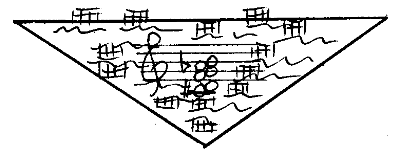
HITHER GATE MUSIC

HITHER GATE MUSIC

Goal: a wash of rhythms that expands and contracts
Source: a single stroke on a Tibetan singing bowl: bellae.wav (4.9 sec).
The preparatory sequence of operations takes the source to a Hi-Pass filtered version of bellae.wav: GAIN reduction by 0.7, CUT from the beginning to 1.1 sec., and DOVETAIL ca. 0.25 sec. linear at the beginning, and 0.85 second exponential at the end, forming: baegcdt.wav. This is put through a HI-PASS FILTER with the passband at 1568 Hz and the stopband at 10 Hz: everything above 1568 Hz is retained, and frequencies below it are gradually filtered away. The output is CUT again 0 to 1.1 sec. This gives us baegcdthipc.mp3. A slightly 'lighter' version, exact parameters not known, possibly a higher passband, and TRANSPOSED up 4 semitones to B-natural (MPV=71) is the variant actually used: baegcdthip2cu4.mp3.
We are aiming for a texture made up of lively rhythms, not separate, but forming a wash that expands downwards & contracts again, a jostling together of driving, energetic rhythmic units. Another objective is to have a harmonic flavour. The function to achieve these objectives is TEXTURE TMOTIFSIN: Timed-MOTIFS-IN (changing harmonic sets).
The rhythmic motif created for this texture is:
and a duration template specifies that it repeats every ½ second. This rhythm is actually specified in numbers: the first 4 semiquavers start at times 0, 0.25, 0.5 and 0.75 sec. The tempo is then doubled to bring it to crotchet = 120.
The ½ sec. duration template is the 'timed' part of the function. This ½ sec. overlap of the rhythmic motif is what makes it sound continous. A sextuplet is included in the motif to help make the rhythms jostle together and fuse into a continuum.
The harmonic flavour is achieved by starting and ending on its original pitch (B-natural), unfurling a 6-note chord and then contracting back to the B. Using the 'changing harmonic set' option in TEXTURE TMOTIFSIN, Mode 3 for 'changing harmonic sets', the chord changes every 2 or 3 seconds as shown below:
These pitches are specified as MPVs: MIDI Pitch Values. Thus the full chord, reading upwards, is 61-62-65-67-68-71. The output duration is specified as 20 seconds, which is why the numbers under the chords go up to 20. These define the time periods during which each set of pitches can be used.

Thus the constraints (specifications) for the texture include a duration template, a harmonic set with 11 changes, and a rhythmic motif.
The software that builds the rhythmic wash texture to these specifications starts the rhythmic motif every half a second, transposing the input sound to the pitches available in each output time period, selecting one of the available pitches at random. The whole motif plays through on the selected pitch. The overall expanding and contracting shape of the texture is very clearly audible. This is what it sounds like: baegcdthip2cu4tz1s5.mp3. The last part of the name indicates that it is used as the 5th section of the 1st Tzolkin cycle of the piece.
Aesthetically, this short texture draws upon various 20th century developments in the way music is put together, particularly the creation of textures which have both free (randomised) and defined components.